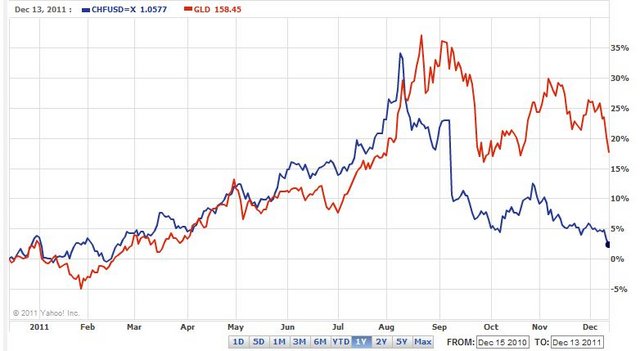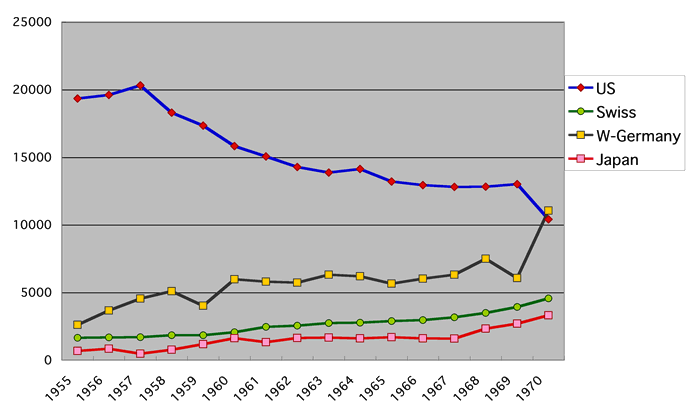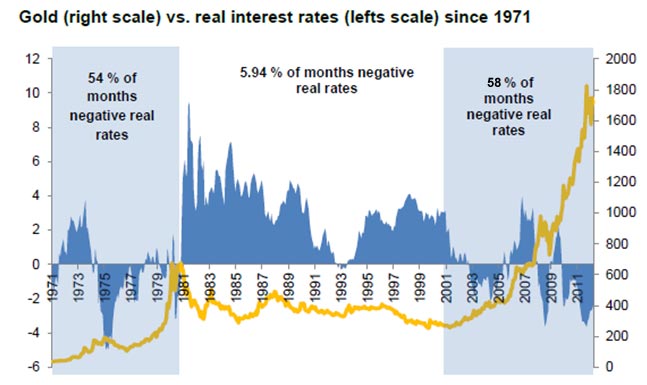Already in 2013, the Swiss National Bank (SNB) spoke out against the gold initiative and revealed that the Swiss Gold is stored mostly in Switzerland and 20% in the UK and 10% in Canada. There is no Swiss gold in the United States according to SNB chairman Jordan. In this post we provide an exchange of the Jordan’s arguments against the gold referendum and our way of viewing it.
The Swiss gold initiative has three demands:
- The gold of the Swiss National Bank must be stored physically in Switzerland.
- The Swiss National Bank does not have the right to sell its gold reserves
- The Swiss National Bank must hold at least twenty percent (20%) of its total assets in gold
In the next two to three years the Swiss people will decide about this initiative in a referendum.
Extracts from the speech given by Thomas J. Jordan Chairman of the Governing Board, at the General Meeting of Shareholders of the Swiss National Bank, 26 April 2013, source and our comments:
Jordan: In my following remarks, I would like to speak about the subject of gold as part of the SNB’s currency reserves. As reported in the media last week, the so-called gold initiative has formally qualified for a referendum vote to be held. This popular initiative demands that the SNB hold at least 20% of its assets in gold, that it be prohibited from selling its gold reserves and that all gold reserves be physically stored in Switzerland itself.
The SNB does not generally comment on any political initiatives. However, the gold initiative has a very direct impact on the SNB’s capacity to act. This is why we are taking the opportunity today to present our viewpoint for the first time on the demands of the initiative. The initiators see a high level of gold reserves as a guarantee for currency stability. They fear that the Swiss franc will decline in value and that price stability will be threatened if a large proportion of the balance sheet does not consist of gold holdings. They are also concerned that the SNB’s gold reserves held abroad are not secure and will not be accessible in critical situations. We share the objectives the initiators put forward, such as maintaining currency and price stability and ensuring both the SNB’s capacity to act and its independence. However, the measures proposed to this effect are not suitable; in fact, they are even counterproductive.
Instead, they are based on misunderstandings about the importance of gold in monetary policy and would compromise the SNB’s capacity to act in pursuing its monetary policy, which would run counter to the objectives envisaged. In other words, these measures would, in certain situations, considerably hinder the SNB in fulfilling its monetary policy mandate and be detrimental to Switzerland. We therefore consider it our duty to point out the serious disadvantages of the initiative already at an early stage.
Having said that, however, the SNB is interested in a dialogue on any questions connected with the initiative. With this in mind, allow me to make a few remarks. The SNB has the statutory mandate to ensure price stability, while taking due account of economic developments. The monetary policy operations that must be carried out in fulfillment of this mandate have a direct impact on the SNB’s balance sheet. In order for the SNB to fulfill its mandate at all times, its capacity to act in monetary policy matters must not be compromised by rigid rules on the composition of its balance sheet, which would be the case with the required 20% minimum share of gold and the ban on the sale of gold. It was precisely the latest crisis that demonstrated how important it is for the SNB to have the flexibility to expand its balance sheet, if needed. In future, the SNB will also need this flexibility to reduce the balance sheet again, if necessary.
Our opinion: The SNB reduced its balance sheet with gold sales until the year 2007, when the gold price was weak. The expansion of its balance sheet from 2008 on was done only based on “fiat currencies”. In 2010 the SNB obtained a big loss on these currencies while the gold price continued to rise.
Jordan: The demands of the initiative would considerably curtail this flexibility. Were the initiative to be accepted, the SNB would in the current environment have to make large scale gold purchases to meet the required 20% minimum share of gold. It would not be allowed to sell this gold at a later point, even if it had to reduce its balance sheet again in order to maintain price stability.
Our comment: The proponents of the initiative suggest to sell the recently acquired fiat currencies again to reduce the balance sheet and obtain price stability.
The demand that the gold reserves cannot be sold are effectively very restrictive and should be over-thought. In the process to a Swiss referendum a counter-proposition may be elaborated.
To a certain extend even central banks should be able to buy more liquid gold ETFs. We judge that a minimum of 10% gold and a target value of 20% over the longer term should be achieved. It should be possible to buy up to 5% in the form of gold ETFs.
As long as the Chinese Renmimbi is not fully convertible and dominated by an authoritarian regime and as long as the US treasuries deliver negative real interest rates, gold is reestablished as reserve currency by many central banks in emerging markets. Effectively the Swiss franc, similarly as gold, as safe proxy to strong Chinese and global expansion, avoiding the risks of holding Chinese assets. The reason are the strong exports of Switzerland and the closely German economy to China.
Jordan: In a worst case scenario, the assets side of the SNB’s balance sheet would, over time, be largely comprised of unsellable gold. Managing the interest rate level and the money supply would only be possible via the liabilities side of the balance sheet; in practice by issuing the SNB’s own interest bearing debt certificates (SNB Bills). This would have serious financial consequences: On the assets side, the SNB would neither have any interest income nor could it realise any profits on gold due to the ban on sales. On the liabilities side, it might have to pay high interest on debt certificates. The SNB could therefore find itself in a situation in which it could only finance its current expenses by means of money creation.
Our opinion: This argument seems to be flawed: If the interest rate of SNB bills rises then we are typically in an inflationary scenario, in which also the gold price increases. With falling inflation both interest on (newly issued) bills and the gold price would fall.
The only exception would be a considerable deterioration of the Swiss economy, in which Swiss inflation is far higher than US inflation that correlates with gold.
Jordan: The far reaching demands of the gold initiative would inevitably have repercussions for our monetary policy. In making its monetary policy decisions, the SNB would have to consider the long-term consequences the necessary gold purchases would have on its capacity to act and on the structure of its balance sheet.
Furthermore, market participants would hardly regard monetary policy decisions as credible, should these decisions involve a substantial expansion of the balance sheet, which in turn would impair the effect of monetary policy. It is unlikely that decisions such as the introduction of the minimum exchange rate or the stabilisation of UBS would have been made in the same way given these circumstances.
Our opinion: During the crisis in Summer 2011, risk aversion drove the gold price to nearly 2000 US$. The gold-related Swiss franc overshot to EUR/CHF of 1.00. The SNB has correctly seen this overvaluation of the franc. As measure the SNB introduced the minimum exchange rate of 1.20. For us this 1.20 was too high. The choice of 1.10 EUR/CHF would have reduced considerably the massive expansion of money supply. This excessive money will lead to misallocation of resources, to a boom and finally to a bust of Swiss real estate.

CHF vs. gold (GLD ETF) in 2011
Instead of buying fiat currencies in huge quantities and financing it with newly printed Swiss franc, the SNB should have been able to sell some gold reserves exactly in that moment, e.g. in the form of ETFs. However, since it sold so much gold earlier (for far cheaper prices), this did not make sense. According to Q4/2012 data, the SNB holds 10% of its assets in gold, with the recent gold devaluation this has become even less.
Jordan: This constraint on the capacity to act would not be in Switzerland’s interest. Gold is nevertheless an important component of the SNB’s assets. However, this is not because gold guarantees price stability. In today’s monetary system, there is no direct connection between the proportion of gold on the SNB’s balance sheet and price stability. This is also evidenced by the fact that the objective of price stability has been better achieved.
In recent years, even though the proportion of gold on our balance sheet was smaller, than at times when gold accounted for a much larger share. A high proportion of gold on the balance sheet is no guarantee for price stability. There is another reason why gold is useful for the SNB and Switzerland. As part of a good diversification of currency reserves, a certain proportion of gold can help reduce the balance sheet risk. We have therefore never ruled out the possibility of future gold purchases.
Our opinion: Effectively the around 15% gold share in 2010 reduced SNB losses for the year 2010 considerably. Gold has two functions for the Swiss: It protects against inflation and helps to reduce balance sheet risks, because the Swiss franc is correlated with gold.
Jordan: At the same time, however, gold is also one of the most volatile and thus riskiest investments. A high proportion of gold would increase the SNB’s balance sheet risk. With the increasing share of gold on the balance sheet, a secondary effect would be that the profit distribution to the Confederation and the cantons would likely be lower. This is because, unlike foreign currency investments, gold does not generate income in the form of interest or dividends, and any valuation gains on gold could not be realised because of the ban on sales.
Our opinion: The recent year have shown that gold is very volatile. The argument that gold generates no income has to be put into perspective with the historically proven fact that gold appreciates in periods of negative real rates and financial repression. Once again we agree with Jordan, that the total ban of gold sales is counterproductive.
Jordan: If, as the initiative demands, a ban on selling gold were to be enshrined in the constitution, the question would arise as to whether an immovable asset of this kind could even still fulfil the function of a currency reserve. Yet, the very purpose of currency reserves is that they are available quickly and without restriction when needed. This availability in a crisis situation is important, even if as is currently the case we are not intending to sell gold.
The availability of gold reserves also plays a role with regard to their storage. Let me therefore take a look at the third component of the initiative, i.e. the demand that all gold reserves be physically stored in Switzerland. Decentralised storage in Switzerland and abroad is in line with the basic principles of due diligence in the conduct of business and business continuity management. It ensures that the SNB can in fact access its gold reserves, especially in an emergency. The same standards are applied to storing gold abroad as to storing gold in Switzerland. Our partner central banks keep clearly identifiable gold bar holdings for the SNB. Each bar stored abroad has a bar identification and remains the property of the SNB. The availability of our gold holdings is fully guaranteed at all times.
As with many other central banks, the SNB has never made the storage locations public. The SNB reviews the geographic allocation of its gold reserves periodically and adjusts it if necessary. In addition to security considerations, avoiding public discussions when gold is being relocated was one of the reasons why storage locations have so far been treated confidentially among central banks. However, the SNB is aware that there has been a growing need for transparency in our population in the last few years. We have therefore decided to provide more detailed information in this matter.
This is the only way for us to rectify the misinformation and misconceptions with regard to storage locations which have increasingly surfaced. Of our 1,040 tonnes of gold, more than 70% and thereby the overwhelming proportion is stored in Switzerland. The remaining 30% is distributed between two countries. Roughly 20% of the gold reserves are kept at the central bank of the United Kingdom, and approximately 10% at the central bank of Canada.
Our comment: There is hence no Swiss gold in the United States.

Development of gold reserves during Bretton Woods era
Similarly as Germans and Japanese, the Swiss accumulated gold reserves during the Bretton Woods era thanks to current account surpluses with the U.S. and the UK.
The gold was often left in a U.S. or UK storage but the ownership changed. Recently Germany uttered plans to repatriate gold from the U.S. and the UK. Germany had 45% of its gold lying at the Federal Reserve, a similar number for the Swiss in the 1990s is possible.
Reason enough to speculate that the SNB let transfer the gold stored in the U.S. to Canada in the 1990s due to the conflict about dormant Swiss account owned by Jews killed in WWII . They possibly feared a U.S. sequestration. We think that most gold that was stored in Canada was sold during the Swiss gold sales from 1999.
It is also possible that the central bank sold the Swiss gold that was remaining in the U.S., but this is for us less probable. They possibly wanted to remove all Swiss gold out of reach of the U.S. authorities.
Jordan: The SNB has been storing gold exclusively in these countries for over ten years. A number of clearly defined criteria are used when selecting countries for gold storage. First, adequate regional diversification and good market access for the storage of gold must be ensured. Second, the country in which the gold is stored must be politically and economically very stable and guarantee the immunity protection of central bank investments.
Our comment: The Swiss gold sales from 2002 on must be executed mostly from the Canadian deposits. The United States was hence politically and economically not stable enough….
Alternatively to a transfer to Canada in the 1990s, it is possible that already during the Bretton Woods period, the Swiss preferred to hold their gold out of the reach of the United States, given that the Fed already blocked Swiss gold holdings in the U.S. already in WWII.1:
This could have been achieved settling the current account surpluses with the U.S. and the resulting gold transactions via the BIS (Bank of International Settlement) depositories or sending the Swiss gold regularly back to Switzerland. The BIS was considered a “gold-friendly” institution, while the United States and the IMF thought that gold as not useful for monetary policy. (read interesting details about the Fed’s attitude towards the BIS).
Jordan: Unlike the other two demands of the gold initiative, the manner of storing the gold reserves has no immediate implications for monetary policy .In our opinion, however, the principles of risk diversification and the requirements of due diligence in the conduct of business still speak for decentralized storage in Switzerland and abroad.

